5+1变速器设计说明书new
5+1变速器设计说明书
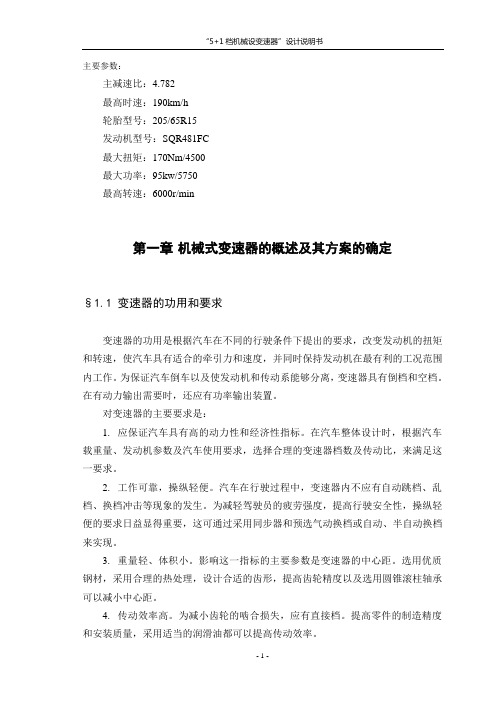
-6-
“5+1 档机械设变速器”设计说明书
间轴上的一挡齿轮, 因而缩短了中间轴的长度。 但换挡时有两对齿轮同时进入啮合, 使换挡困难。图 1-6c 所示方案能获得较大的倒挡传动比,缺点是换挡程序不合理。 图 1-6d 所示方案针对前者的缺点做了修改,因而取代了图 1-6c 所示方案。图 1-6e 所示方案是将中间轴上的一,倒挡齿轮做成一体,将其齿宽加长。图 1-6f 所示方 案适用于全部齿轮副均为常啮合齿轮,换挡更为轻便。为了充分利用空间,缩短变 速器轴向长度,有的货车倒挡传动采用图 1-6g 所示方案。其缺点是一,倒挡须各 用一根变速器拨叉轴,致使变速器上盖中的操纵机构复杂一些。 本设计采用图 1-6f 所示的传动方案。
-1-
“5+1 档机械设变速器”设计说明书
5. 噪声小。采用斜齿轮传动及选择合理的变位系数,提高制造精度和安装刚 性可减小齿轮的噪声。
§1.2 变速器结构方案的确定
变速器由传动机构与操纵机构组成。 1.变速器传动机构的结构分析与型式选择 有级变速器与无级变速器相比,其结构简单、制造低廉,具有高的传动效率 (η=0.96~0.98) ,因此在各类汽车上均得到广泛的应用。 设计时首先应根据汽车的使用条件及要求确定变速器的传动比范围、档位数及 各档的传动比,因为它们对汽车的动力性与燃料经济性都有重要的直接影响。 传动比范围是变速器低档传动比与高档传动比的比值。汽车行驶的道路状况愈 多样,发动机的功率与汽车质量之比愈小,则变速器的传动比范围应愈大。目前, 轿车变速器的传动比范围为 3.0~4.5;一般用途的货车和轻型以上的客车为 5.0~8.0; 越野车与牵引车为 10.0~20.0。 通常,有级变速器具有 3、4、5 个前进档;重型载货汽车和重型越野汽车则采 用多档变速器,其前进档位数多达 6~16 个甚至 20 个。 变速器档位数的增多可提高发动机的功率利用效率、汽车的燃料经济性及平均 车速,从而可提高汽车的运输效率,降低运输成本。但采用手动的机械式操纵机构 时,要实现迅速、无声换档,对于多于 5 个前进档的变速器来说是困难的。因此, 直接操纵式变速器档位数的上限为 5 档。多于 5 个前进档将使操纵机构复杂化,或 者需要加装具有独立操纵机构的副变速器,后者仅用于一定行驶工况。 某些轿车和货车的变速器,采用仅在好路和空载行驶时才使用的超速档。采用 传动比小于 1(0.7~0.8)的超速档,可以更充分地利用发动机功率,降低单位行驶 里程的发动机曲轴总转数,因而会减少发动机的磨损,降低燃料消耗。但与传动比 为 1 的直接档比较,采用超速档会降低传动效率。 有级变速器的传动效率与所选用的传动方案有关,包括传递动力的齿轮副数 目、转速、传递的功率、润滑系统的有效性、齿轮及轴以及壳体等零件的制造精度、 刚度等。 三轴式和两轴式变速器得到的最广泛的应用。 三轴式变速器如图 1-1 所示,其第一轴的常啮合齿轮与第二轴的各档齿轮分别
5+1变速器设计-推荐下载
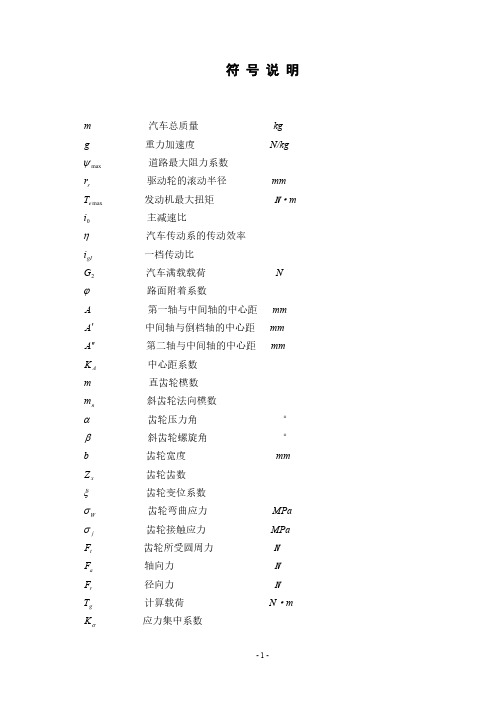
-1-
kg
N/kg
mm
N·m
N
°
°
mm
MPa
MPa
N
N
N
N·m
Kf
E
K
rz
rb
z
b
T
WT
G
IP
fc
fs
摩擦力影响系数
齿轮材料的弹性模量
重合度影响系数
主动齿轮节圆半径
从动齿轮节圆半径
主动齿轮节圆处的曲率半径 mm
从动齿轮节圆处的曲率半径 mm
扭转切应力
轴的抗扭截面系数
轴的材料的剪切弹性模量 MPa
从现在市场上不同车型所配置的变速器来看,主要分为:手动变速器(MT)、 自动变速器(AT)、手动/自动变速器(AMT)、无级变速器(CVT)。
一、手动变速器(MT) 手动变速器(Manual Transmission)采用齿轮组,每档的齿轮组的齿数是固定 的,所以各档的变速比是个定值(也就是所谓的“级” )。比如,一档变速比是 3.85,二 档是 2.55,再到五档的 0.75,这些数字再乘上主减速比就是总的传动比,总共只有 5 个值(即有 5 级),所以说它是有级变速器。 曾有人断言,繁琐的驾驶操作等缺点,阻碍了汽车高速发展的步伐,手动变 速器会在不久“下课”,从事物发展的角度来说,这话确实有道理。但是从目前市 场的需求和适用角度来看,笔者认为手动变速器不会过早的离开。 首先,从商用车的特性上来说,手动变速器的功用是其他变速器所不能替代 的。以卡车为例,卡车用来运输,通常要装载数吨的货品,面对如此高的“压力”, 除了发动机需要强劲的动力之外,还需要变速器的全力协助。我们都知道一档有 “劲”,这样在起步的时候有足够的牵引力量将车带动。特别是面对爬坡路段,它 的特点显露的非常明显。而对于其他新型的变速器,虽然具有操作简便等特性, 但这些特点尚不具备。 其次,对于老司机和大部分男士司机来说,他们的最爱还是手动变速器。从 我国的具体情况来看,手动变速器几乎贯穿了整个中国的汽车发展历史,资历郊 深的司机都是“手动”驾车的,他们对手动变速器的认识程度是非常深刻的,如 果让他们改变常规的做法,这是不现实的。虽然自动变速器以及无级变速器已非 常的普遍,但是大多数年轻的司机还是崇尚手动,尤其是喜欢超车时手动变速带 来的那种快感,所以一些中高档的汽车(尤其是轿车)也不敢轻易放弃手动变速 器。另外,现在在我国的汽车驾驶学校中,教练车都是手动变速器的,除了经济 适用之外,关键是能够让学员打好扎实的基本功以及锻炼驾驶协调性。
变速器设计说明书
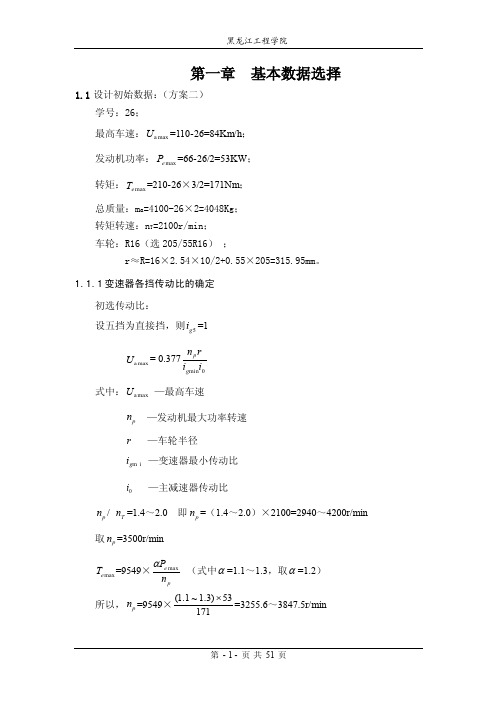
第一章 基本数据选择1.1设计初始数据:(方案二)学号:26;最高车速:max a U =110-26=84Km/h ; 发动机功率:max e P =66-26/2=53KW ; 转矩:max e T =210-26×3/2=171Nm ; 总质量:m a =4100-26×2=4048Kg ;转矩转速:n T =2100r/min ; 车轮:R16(选205/55R16) ;r ≈R=16×2.54×10/2+0.55×205=315.95mm 。
1.1.1 变速器各挡传动比的确定初选传动比:设五挡为直接挡,则5g i =1 max a U = 0.377min i i r n g p式中:max a U —最高车速p n —发动机最大功率转速 r —车轮半径m i n g i —变速器最小传动比 0i —主减速器传动比p n / T n =1.4~2.0 即p n =(1.4~2.0)×2100=2940~4200r/min 取p n =3500r/minmax e T =9549×pe n P maxα (式中α=1.1~1.3,取α=1.2)所以,p n =9549×17153)3.1~1.1(⨯=3255.6~3847.5r/min0i =0.377×max i i rn g p =0.377×841095.31535003-⨯⨯=4.963 双曲面主减速器,当0i ≤6时,取η=90%,0i ›6时,η=85%。
轻型商用车1g i 在5.0~8.0范围,g η=96%, T η=η×T η=90%×96%=86.4%最大传动比1g i 的选择:①满足最大爬坡度。
根据汽车行驶方程式dtdumGi u A C Gf ri i T a D Tg δη+++=20emax 15.21 (1.1)汽车以一挡在无风、干砂路面行驶,公式简化为ααηsin cos 0emax G Gf ri i T Tg += (1.2)即,()Ttq g i T f Gr i ηαα01sin cos +≥式中:G —作用在汽车上的重力,mg G =,m —汽车质量,g —重力加速度,mg G ==4840×9.8=47432N ;max e T —发动机最大转矩,max e T =171N .m ; 0i —主减速器传动比,0i =4.963;T η—传动系效率,T η=86.4%;r —车轮半径,r =0.316m ;f —滚动阻力系数,对于货车取f =0.02;α—爬坡度,取α=16.7°%4.86963.4171316.07.16sin 7.16cos 02.08.940481⨯⨯⨯︒+︒⨯⨯⨯≥)(g i =5.24②满足附着条件。
毕业设计(论文)-中型货车变速器设计(5+1档)

前言汽车作为商品在世界各地都有广阔的市场,又因为生产批量大个给企业带来丰厚的利润。
汽车的多样性可以满足各种生产生活的需求,而更重要的是,汽车工业的发展带动了许多相关产业的发展,比如钢铁、石油、橡胶、塑料、机床、道路、汽车销售、运输、交通管理、金融业等等一系列产业的发展,解决了大批人员的就业问题。
汽车作为我国的支柱产业,其重要性不言而喻,而变速器作为汽车的核心部件之一,在很大程度上决定了汽车的性能,因此设计出一款结构合理、制造成本适中、轮廓尺寸和质量尽可能小的变速器也就是重中之重。
本次的毕业设计主要是考察我们即将毕业的大学生在这四年里所学的专业知识,同时也是将所有的科目进行一次综合性的考核,可以让我们清楚的知道自己在大学中到底学到了多少知识,以及对各科目知识的运用能力,这些对我们以后走上工作岗位都是有着积极的意义。
本人的设计题目是:中型货车变速器设计(5+1)档设计工作量:1、集资料、进行方案论证、结构分析,确定合理的结构方案。
2、选择正确的参数,对变速器的强度及刚度进行校核计算。
3、三维建模,变速器结构图;绘CAD图(A1)一张。
4、设计中的计算要求编程,上机计算,打印程序、结果。
5、英译中大于5000字符(折合中文约大于3000字)。
6、设计说明书应包括:目录、中、英文摘要、设计说明、方案论证、计算过程、结论、毕业设计完成情况的自我评价及其它说明。
要求大于1.2万字。
设计参数:发动机最大扭矩:355(N.m); 一档传动比:6.28 ; 主减速器减速比:5.6。
要求:1、方案合理,结构正确,满足变速器的功用;2、设计计算准确,达到强度、刚度、寿命及其它指标;3、运用编程计算,计算机绘图;4、说明书内容完整,图纸表达清楚,英文翻译文理通畅。
最后,由于本人的设计经验和知识水平有限,在设计中出现的问题敬请各位老师和同学的指正。
编者:陈鹏2012.5第1章变速器的功用和要求现代汽车采用的活塞式内燃发动机转矩变化范围较小,不能适应汽车在各种条件下阻力变化的要求,因此在汽车传动系中,采用了可以改变转速比和传动转矩比的装置,即变速器。
5+1变速器设计说明书另外有完整图纸

符号说明m汽车总质量kgg重力加速度N/kg ψ道路最大阻力系数maxr驱动轮的滚动半径mm rT发动机最大扭矩N·m emaxi主减速比η汽车传动系的传动效率i一档传动比gIG汽车满载载荷N 2ϕ路面附着系数A第一轴与中间轴的中心距mm A'中间轴与倒档轴的中心距mmA''第二轴与中间轴的中心距mmK中心距系数Am直齿轮模数m斜齿轮法向模数nα齿轮压力角°β斜齿轮螺旋角°b齿轮宽度mmZ齿轮齿数xξ齿轮变位系数σ齿轮弯曲应力MPa Wσ齿轮接触应力MPa jF齿轮所受圆周力NtF轴向力 N aF径向力NrT计算载荷N·m gK应力集中系数σf K 摩擦力影响系数E 齿轮材料的弹性模量 MPaK ε 重合度影响系数z r 主动齿轮节圆半径 mmb r 从动齿轮节圆半径 mmz ρ 主动齿轮节圆处的曲率半径 mmb ρ 从动齿轮节圆处的曲率半径 mmT τ 扭转切应力 MPaT W 轴的抗扭截面系数 3mmG 轴的材料的剪切弹性模量 MPaP I 轴截面的极惯性矩 4mmc f 垂直面内的挠度 mms f 水平面内的挠度 mm前言现在,每当人们观看F1大赛,总会被那种极速的感觉所折服。
此刻,大家似乎谈论得最多的就是发动机的性能以及车手的驾驶技术。
而且,不忘在自己驾车的时候体会一下极速感觉或是在买车的时候关注一下发动机的性能,这似乎成为了横量汽车品质优劣的一个标准。
的确,拥有一颗“健康的心”是非常重要的,因为它是动力的缔造者。
但是,掌控速度快慢的,却是它身后的变速器。
从现在市场上不同车型所配置的变速器来看,主要分为:手动变速器(MT)、自动变速器(AT)、手动/自动变速器(AMT)、无级变速器(CVT)。
一、手动变速器(MT)手动变速器(Manual Transmission)采用齿轮组,每档的齿轮组的齿数是固定的,所以各档的变速比是个定值(也就是所谓的“级”)。
客货两用车5+1档变速器设计-毕业设计(论文)开题报告

围绕汽车变速箱四个研究方向,各国汽车变速器专家展开了激烈的角逐。
①摩擦传动CVT
金属带式无级变速箱(VDT-CVT)的传动功率已能达到轿车实用的要求,装备金属带式无级变速箱的轿车已达100多万辆。据报道:大排量6缸内燃机(2.8L)的奥迪A6轿车上装备的金属带式无级变速箱Multitronic CVT,能传动142kw(193bhp)功率,280Nm扭矩。这是真正意义的无级变速器。
学生姓名
专业班级
课题类型
指导教师
职称
课题来源
1.设计(或研究)的依据与意义
汽车是重要的交通运输工具,其设计和制造水平是各国科学技术发展水平的重要标志,汽车工业是资金密集、技术密集、人才密集、综合性强、经济效益高的产业。世界各个工业发达的国家几乎无一例外地把汽车工业作为国民经济的支柱产业,汽车的研制、生产、销售、营运,与国民经济许多部门都息息相关,对社会经济建社和科学技术发展起重要的推动作用。汽车也是社会物质生活发展水平的标志。汽车的保有量随着国展人均收入水平的提高而增加。在许多发达国家中,汽车的数量巨大并已普及到千家万户,进而促使人们在社会生活方式发生了显著的变化。
(1)采用4D20D发动机,最大功率(kw/r/min)105/4000,最大转矩(Nm/r/min)315/1400-2800,前置后驱,最高车速不小于100km/h,坡度不小于20%;
无级变速器设计说明书
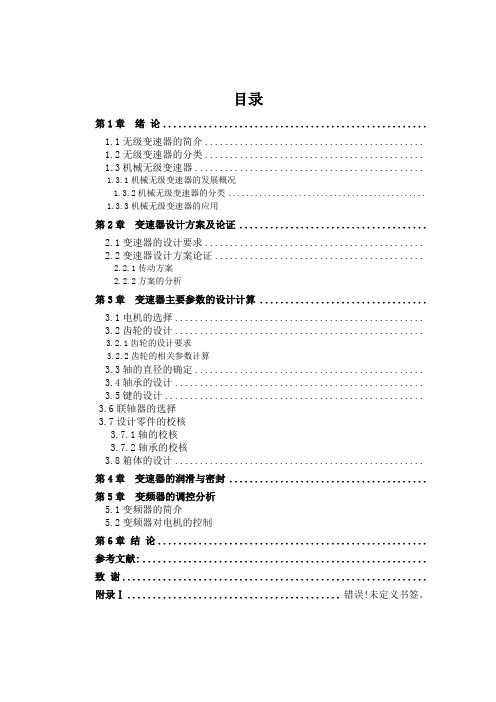
目录第1章绪论....................................................1.1无级变速器的简介............................................1.2无级变速器的分类............................................1.3机械无级变速器..............................................1.3.1机械无级变速器的发展概况1.3.2机械无级变速器的分类 .............................................1.3.3机械无级变速器的应用第2章变速器设计方案及论证 .....................................2.1变速器的设计要求............................................2.2变速器设计方案论证..........................................2.2.1传动方案2.2.2方案的分析第3章变速器主要参数的设计计算 .................................3.1电机的选择..................................................3.2齿轮的设计..................................................3.2.1齿轮的设计要求3.2.2齿轮的相关参数计算3.3轴的直径的确定..............................................3.4轴承的设计..................................................3.5键的设计....................................................3.6联轴器的选择3.7设计零件的校核3.7.1轴的校核3.7.2轴承的校核3.8箱体的设计..................................................第4章变速器的润滑与密封 .......................................第5章变频器的调控分析5.1变频器的简介5.2变频器对电机的控制第6章结论.....................................................参考文献: ........................................................致谢............................................................附录Ⅰ......................................... 错误!未定义书签。
轻型客车变速器设计 说明书

摘要变速器是汽车重要的传动系组成,在较大范围内改变汽车行驶速度的大小和汽车驱动轮上扭矩的大小。
变速器能在发动机旋转方向不变的前提下,使汽车倒退行驶,而且利用挡位可以中断动力的传递。
所以变速器的结构设计的合理性直接影响到汽车动力性和经济性。
设计要求达到换挡迅速、省力、方便、有较高的工作效率、工作噪声低。
本次设计的是轻型客车变速器设计。
它的布置方案采用中间轴式5+1挡和锁环式同步器换挡,并对倒挡齿轮和拨叉进行合理布置,其中一轴和第二轴的轴线在同一直线上。
这种布置形式缩短了变速器轴向尺寸,在保证挡数不变的情况下,减少齿轮数目,从而使变速器结构更加紧凑。
首先利用已知参数确定变速器各挡传动比、中心矩,然后确定齿轮的模数、压力角、齿宽等参数。
由中心矩确定箱体的长度、高度和中间轴及二轴的轴径,然后对中间轴和各挡齿轮进行校核,验证各部件选取的可靠性。
最后绘制装配图及零件图。
设计结论表明,变速器齿轮及各轴尺寸确定,各轴强度的校核满足设计要求,设计结构合理。
关键词:客车;变速器;同步器AbstractThe transmission gearbox, as an important part in automobile driving system is used to make up the shortcoming of engine torque and rotary speed. It can change the vehicle speed and type torque in a big scope, cut off the power transfer from the engine, and also provides a reverse traveling direction for the vehicle. Therefore, the reasonability of the structure design of a transmission gearbox directly affects the vehicle's dynamic performance. It is usually required shifting gears rapidly and conveniently, saving force, and having a higher working efficiency and low working noises.This thesis designed a manual transmission gearbox of the Light bus. A scheme of structure with middle shafts, six (5+1) shifts and synchronizer was adopted here, Combine to pour to block wheel gear and stir fork to carry on a reasonable decoration .where the first and second shafts were arranged in line. This kind of structure reduces the gearbox dimension in the axis direction, in assurance block to count under the constant circumstance, decrease wheel gear number. Therefore makes the designed transmission gearbox more compact.Using the given basic parameters, it was firstly determined the transmission ratio of each shift, the shaft center distances, the gear modulus, the gear pressing angles and widths, and so on. And then the general dimension of the gearbox, including its length, width and height. The stresses of the intermediate shaft and the gears were validated by using both the calculator and a self-made MATLAB program. Finally, some engineering drawings were carried out.The calculated results show: the determined dimensions and stresses of the designed gears and shafts satisfied the design requirements; the adopted structure is reasonable.Key words:Light; Transmission gearbox; Synchronizer目录第1章绪论 (1)1.1 变速器的简介 (1)1.2变速器的分类 (1)1.3变速器的功用 (2)1.4变速器的构成 (3)第2章变速器设计方案及论证 (4)2.1变速器的要求: (4)2.2变速器设计方案论证 (4)第3章各主要参数的设计计算 (7)3.1传动比的确定 (7)3.2中心距的初步确定 (7)3.3变速器的外形尺寸 (8)3.4轴的直径的初步确定 (8)3.5齿轮参数设计 (8)3.6各挡齿数的分配 (10)3.6.1确定一挡齿轮的齿数 (11)3.6.2二挡斜齿轮齿数的确定 (12)3.6.3三挡齿轮齿数的确定 (12)3.6.4五挡齿轮齿数的确定 (13)3.6.5倒挡齿轮齿数的确定 (13)3.7齿轮变位系数的确定 (13)第4章变速器各挡齿轮的校核 (15)4.1齿轮弯曲应力计算 (15)4.1.1中间轴一挡直齿轮Z10校核 (15)校核 (16)4.1.2中间轴二挡斜齿轮Z8校核 (16)4.1.3中间轴三挡斜齿轮Z64.1.4中间轴四挡斜齿轮Z2校核 (16)4.1.5中间轴五挡斜齿轮Z校核 (16)44.2齿轮接触应力计算 (17)4.2.1 中间轴一挡直齿轮Z10校核 (17)4.2.2中间轴二挡斜齿轮Z8校核 (18)4.2.3中间轴三挡斜齿轮Z6校核 (18)4.2.4中间轴四挡齿轮Z2校核 (19)4.2.5中间轴五挡齿轮Z4校核 (19)第5章变速器中间轴的校核 (21)5.1对中间轴四挡齿轮处进行强度校核 (22)5.2对中间轴五挡齿轮处进行强度校核 (23)5.3对中间轴三挡齿轮处进行强度校核 (24)5.4对中间轴二挡齿轮处进行强度校核 (24)5.5对中间轴一倒挡齿轮处进行强度校核 (25)第6章同步器的设计 (27)6.1 同步器的工作原理 (27)6.2同步器的参数的确定 (28)6.2.1摩擦因数 (28)6.2.2同步环主要尺寸确定 (28)第7章变速器操纵机构 (30)7.1 对变速器操纵机构的要求 (30)7.2 直接操纵手动换挡变速器 (30)7.3 远距离操纵手动换挡变速器 (31)7.4 变速器自锁、互锁、倒挡锁装置 (31)7.4.1自锁装置 (31)7.4.2互锁装置 (32)7.4.3倒挡锁装置 (32)第8章变速器轴承 (33)第9章变速器的润滑与密封 (34)第10章结论 (35)参考文献: (36)致谢 (37)附录Ⅰ (38)第1章绪论1.1 变速器的简介变速器是能固定或分档改变输出轴和输入轴传动比的齿轮传动装置。
5+1变速器说明书

车辆与交通工程学院课程设计说明书设计类型专业课程设计设计题目 5+1档变速器设计(有超速档)姓名院系车辆与交通工程学院完成日期2016.3.18指导教师目录第一章机械式变速器方案的确定................................................................ 错误!未定义书签。
§1.1 变速器传动机构布置方案的确定............................................... 错误!未定义书签。
§1.2变速器主要参数的选择................................................................ 错误!未定义书签。
第二章变速器的设计与计算........................................................................ 错误!未定义书签。
§2.1 轮齿强度计算............................................................................... 错误!未定义书签。
§2.2轴的计算........................................................................................ 错误!未定义书签。
§2.3 轴上花键的计算........................................................................... 错误!未定义书签。
第三章变速器同步器的设计........................................................................ 错误!未定义书签。
三轴五档变速器设计说明书
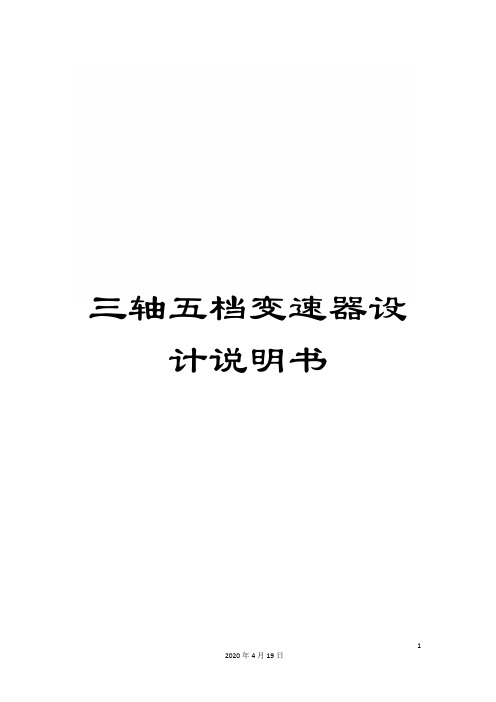
三轴五档变速器设计说明书高级轿车三轴五档手动机械式变速器目录一、设计任务书 (4)二、机械式变速器的概述及总体方案论证 (4)2.1 变速器的功用、要求、发动机布置形式分析 (4)2.2 变速器传动机构布置方案 (5)2.2.1 传动机构布置方案分析 (5)2.2.2 倒挡布置方案 (7)2.3 变速器零部件结构方案分析 (8)三、变速器主要参数的选择与主要零件的设计 (11)3.1 变速器主要参数选择 (11)3.1.1 档数与传动比 (13)3.1.2 中心距 (14)3.1.3 外形尺寸 (14)3.1.4 齿轮参数 (15)3.2 各档齿轮齿数的分配 (15)3.2.1 确定一档齿轮的齿数 (15)3.2.2 确定常啮合齿轮副的齿数 (16)3.2.3 确定其它档位的齿数 (18)3.2.4 确定倒挡齿轮的齿数 (18)3.3 齿轮变位系数的选择 (19)四、变速器齿轮的强度计算与材料的选择 (22)4.1 齿轮的损坏原因及形式 (22)4.2齿轮的强度计算与校核 (22)4.2.1齿轮弯曲强度计算 (23)4.2.2齿轮接触应力 (24)五、变速器轴的强度计算与校核 (26)5.1变速器轴的结构和尺寸 (26)5.1.1 轴的结构 (26)5.1.2 确定轴的尺寸 (26)5.2轴的校核 (27)5.2.1 第一轴的强度与刚度校核 (28)5.2.2 第二轴的校核计算 (29)六、变速器同步器的设计及操纵机构 (30)6.1 同步器的结构 (31)6.2 同步环主要参数的确定 (33)6.3 变速器的操纵机构 (35)参考文献 (36)一、设计任务书某款四座高级轿车整备质量1458kg,拟设计最高车速203km •h-1,最大功率124kW,对应转速6000r/min;最大转矩226N•m,对应转速4000r/min,前后轮胎尺寸均为205/60 R16。
第四组(1)画出手动机械式变速器的总装配图(0号图纸);(2)画出所有手动机械式变速器内零部件图纸(需要标注装配尺寸、配合公差与明细栏,撰写装配技术要求等);(0/1/2/3号图纸)(3)选取、设计和确定手动机械式变速器内各零部件结构、尺寸等,能实现所设计零部件的相关功能要求;(4)校核手动机械式变速器内的关键零部件;(5)设计说明书一份(5000字左右)二、机械式变速器的概述及总体方案论证2.1 变速器的功用、要求、发动机布置形式分析变速器用来改变发动机传到驱动轮上的转矩和转速,目的是在原地起步、爬坡、转弯、加速等各种行驶工况下,使汽车获得不同的牵引力和速度,同时使发动机在最有利的工况范围内工作。
最新变速器课程设计说明书
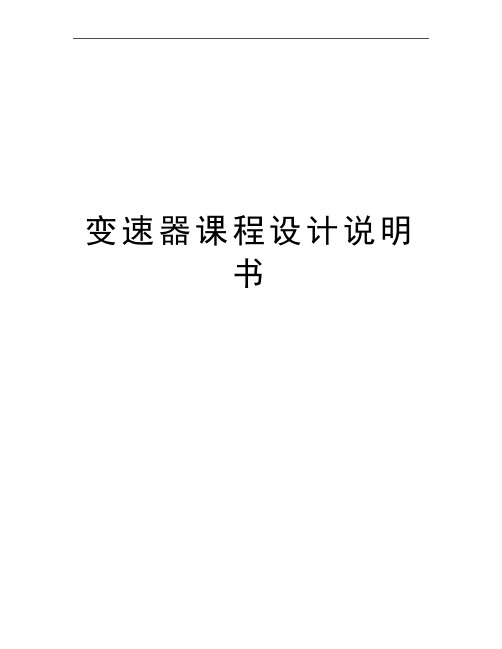
变速器课程设计说明书目录目录 0第1章变速器的设计与计算 (1)1 方案的选择 (1)2 档数 (1)3 传动比范围 (1)4变速器各档传动比的确定 (2)5 中心距的选择 (4)6变速器的外形尺寸 (4)变速器的横向外形尺寸,可以根据齿轮直径以及倒档中间齿轮和换档机构的布置初步确定。
影响变速器壳体轴向尺寸的因素有档数、换档机构形式以及齿轮形式。
. 4货车变速器壳体的轴向尺寸可参考下列公式选用: (4)⨯==AL mm (4)5.3=5.3.625653737齿轮参数的选择 (4)8各档齿轮齿数的分配及传动比的计算 (6)第2章变速器齿轮强度校核 (11)1齿轮材料的选择原则 (11)2变速器齿轮弯曲强度校核 (11)第3章轴的设计和校核 (17)1轴的结构和尺寸设计 (17)2初选轴的直径 (17)3轴的刚度计算 (17)4轴的强度计算 (20)第4章轴承的选择和校核 (30)1 中间轴轴承的选择与寿命计算 (30)2 输出轴轴承的选择与寿命计算 (31)参考文献 (33)第1章变速器的设计与计算1 方案的选择最高车速 120 Km/h整车总质量 4800 Kg最大功率 55 Kw最大转矩 201 N·m最大转矩转速 2250 r/min前轮胎规格165/60 R142 档数近年来,为了降低油耗,变速器的档数有增加的趋势。
目前,乘用车一般用5~6个档位的变速器。
发动机排量大的乘用车变速器多用6个档。
商用车变速器采用4~5个档或多档。
载质量在2.0~3.5t的货车采用五档变速器,载质量在4.0~8.0t的货车采用六档变速器。
多档变速器多用于总质量大些的货车和越野汽车上。
档数选择的要求:1、相邻档位之间的传动比比值在1.8以下。
2、高档区相邻档位之间的传动比比值要比低档区相邻档位之间的比值小。
因此,本次设计的变速器为6档变速器。
3 传动比范围变速器传动比范围是指变速器最高档与最低档传动比的比值。
5+1变速器说明书
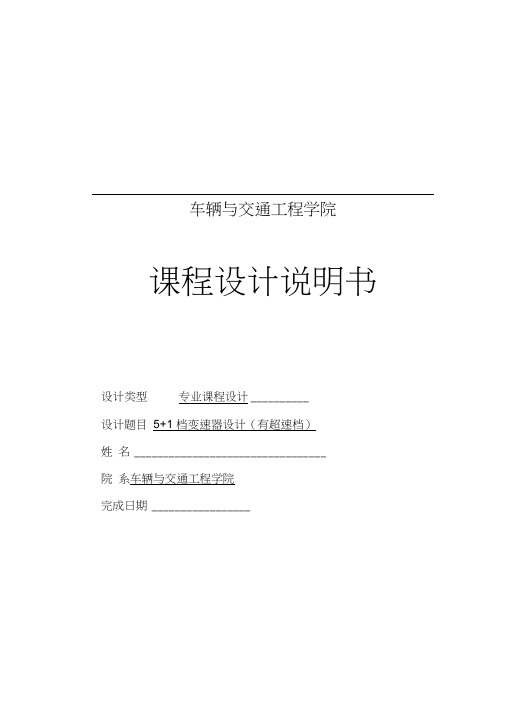
车辆与交通工程学院课程设计说明书设计类型专业课程设计__________设计题目5+1 档变速器设计(有超速档)姓名_________________________________院系车辆与交通工程学院完成日期_________________指导教师___________________________目录第一章机械式变速器方案的确定 ................... 错误!未定义书签。
§变速器传动机构布置方案的确定 .................. 错误!未定义书签。
§变速器主要参数的选择.................... 错误!未定义书签。
第二章变速器的设计与计算 ..................... 错误!未定义书签。
§轮齿强度计算......................... 错误!未定义书签。
§轴的计算.......................... 错误!未定义书签。
§轴上花键的计算....................... 错误!未定义书签。
第三章变速器同步器的设计 ..................... 错误!未定义书签。
§同步器的结构......................... 错误!未定义书签。
§同步环主要参数的确定.................... 错误!未定义书签。
第四章变速器的操纵机构 ...................... 错误!未定义书签。
第五章润滑与密封 ...................... 错误!未定义书签。
§润滑............................. 错误!未定义书签。
§密封............................. 错误!未定义书签。
第六章心得体会与参考文献 ................... 错误!未定义书签。
基于逆向工程的C51变速器设计-任务书
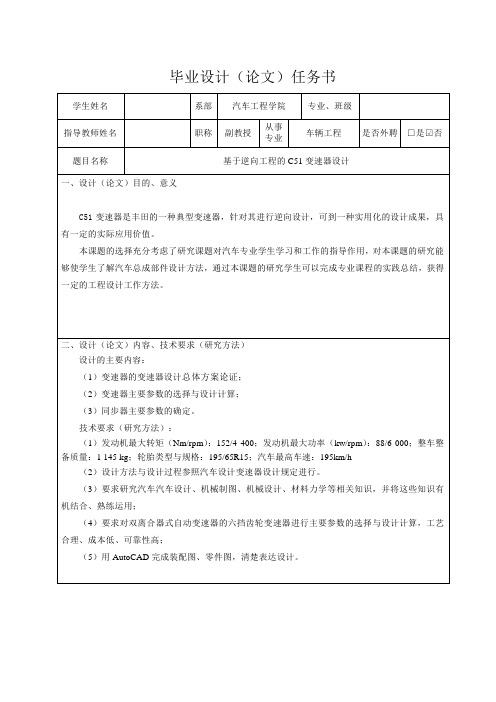
(3)设计手册:机械设计手册等;
(4)网络资源:检索关键词:双离合器、自动变速器、齿轮变速器等;
(5)其它:相关产品广告,参观有关产品展览会。
六、备注
指导教师签字:
年 月 日
教研室主任签字:
年 月 日
二、设计(论文)内容、技术要求(研究方法)
设计的主要内容:
(1)变速器的变速器设计总体方案论证;
(2)变速器主要参数的选择与设计计算;
(3)同步器主要参数的确定。
技术要求(研究方法):
(1)发动机最大转矩(Nm/rpm):152/4 400;发动机最大功率(kw/rpm):88/6000;整车整备质量:1145 kg;轮胎类型与规格:195/65R15;汽车最高车速:195km/h
三、设计(论文)完成后应提交的成果
(1)设计说明书(>2.0万字);
(2)装配图、部件装配图及主要零件图图纸合计4张0号以上(要求计算机绘图)。
四、设计(论文)进度安排
(1)调研、资料收集,完成开题报告第1、2周
(2)C51变速器测绘第3、4周
(3)变速器主要参数的选择与设计计算第5、6周
(4)变速器实体建模与仿真分析第7、8周
(2)设计方法与设计过程参照汽车设计变速器设计规定进行。
(3)要求研究汽车汽车设计、机械制图、机械设计、材料力学等相关知识,并将这些知识有机结合、熟练运用;
(4)要求对双离合器式自动变速器的六挡齿轮变速器进行主要参数的选择与设计计算,工艺合理、成本低、可靠性高;
(5)用AutoCAD完成装配图、零件图,清楚表达设计。
(5)完成所设计装配图与零件图图纸第9、10周
五速同步手动变速箱用户操作指南说明书
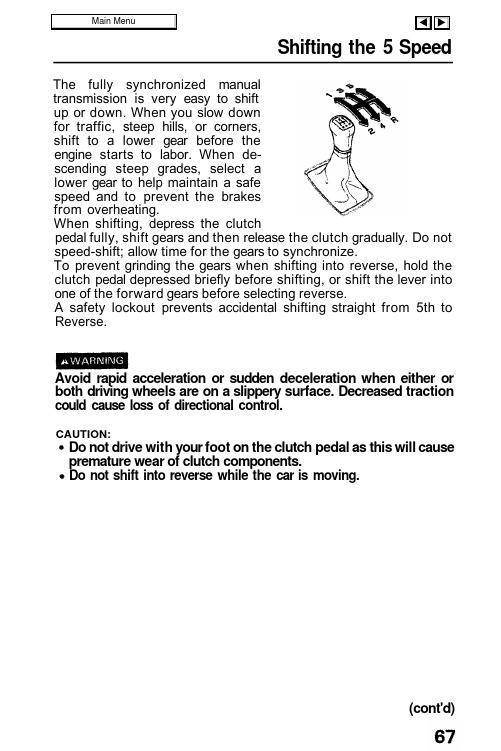
Shifting the 5 SpeedThe fully synchronized manualtransmission is very easy to shiftup or down. When you slow downfor traffic, steep hills, or corners,shift to a lower gear before theengine starts to labor. When de-scending steep grades, select alower gear to help maintain a safespeed and to prevent the brakesfrom overheating.When shifting, depress the clutchpedal fully, shift gears and then release the clutch gradually. Do not speed-shift; allow time for the gears to synchronize.To prevent grinding the gears when shifting into reverse, hold the clutch pedal depressed briefly before shifting, or shift the lever into one of the forward gears before selecting reverse.A safety lockout prevents accidental shifting straight from 5th to Reverse.Avoid rapid acceleration or sudden deceleration when either or both driving wheels are on a slippery surface. Decreased traction could cause loss of directional control.CAUTION:Do not drive with your foot on the clutch pedal as this will causepremature wear of clutch components.Do not shift into reverse while the car is moving.(cont'd)Shifting the 5 Speed (cont'd)Maximum Allowable SpeedsThe speeds shown below are the maximum at which the car can be driven or downshifted in each gear without over-revving the engine.Recommended Shift SpeedsFor best fuel economy, and effective emission control, shift at the speeds shown:Shifting the AutomaticThe automatic transmission shift lever has a locking mechanism to prevent accidental shifting into Reverse (R), Park (P) or 2nd (2). Also,an Automatic Shift Lock prevents you from shifting out of Park unless the brake pedal is already depressed and the ignition switch is in the II position.Push the button on the shift handle to shift into 2nd, Reverse or Park; depress the brake pedal and then push the button on the shifthandle to shift out of Park.: Depress the brake pedal firstand push the button, then shift.: Push the button, then shift.: Shift as desired.If you cannot shift out of Park with the brake pedal depressed and the ignition switch in the II position:1.Turn the ignition switch off and remove the key.2. Insert the key in the Shift Lock Release located to the right of the shift lever.3. Press and hold the key down,then press the button on the shift handle and move the shift lever to Neutral.4. Return the key to the ignition switch, depress the brake pedal and restart the engine.NOTE:If you encounter any problem shifting out of Park, have your authorized Honda dealer check the system as soon as possible.Depress buttonInsertSHIFT LOCK RELEASEKEY(cont'd)Operating TipsFor smoother operation, apply the brakes when shifting from Neutral or Park to a forward or reverse gear.When parking: bring the car to a stop with the foot brake, hold the brake on and shift into Park, set the hand brake and then turn off the engine.NOTE:Your 4 speed automatic transmission is equipped with a torque converter lock-up clutch. Because of this, you may notice what feels like an extra shift as the clutch engages.CAUTION:Shift into P only after the car has come to a complete stop.Shift into or out of R only after the car has come to a complete stop.Do not "rev-up" the engine when the brake is on and the shiftlever is in D, S, 2 or R.When stopped on a hill, use the brakes to hold your position, not the accelerator pedal.Do not shift from N or P into D, S, 2 or R when the engine is above idle speed. Before shifting into gear, make sure your footis firmly on the brake pedal.Do not rest your hand on the shift lever or push the shift button while driving.Driving TechniqueD-4thUse the D range for normal in-town and highway driving. The car will start off in 1st and shift automatically to 2nd, 3rd, and 4th. The further down you push the accelerator, the later the transmission will shift and the faster the car will accelerate.S 3 / S 4The "S " shift selector range changes the shift points under part throttle acceleration, allowing the transmission to stay in each lower gear for a longer period before automatically upshifting. With the shift selector in the "S " range, the "S 3" indicator light in the instrument panel will come on and the transmission will shift from 1st to 2nd and 3rd but not 4th. This is especially useful when climbing or descending grades. While driving in the "S " range, the car's performance is improved but fuel economy is reduced.Shifting the Automatic (cont'd)While driving in the "S " range, you can select 4th gear by pushing th e "S 4" switch. Depending upon vehicle speed and throttle pedal position, the transmission will shift to 4th gear when the switch is pressed ; the "S 4" indicator light in the instrument panel will come on . Pushing the "S 4" switch again will cause the transmission to downshift to 3rd gear in the "S 3" mode. The "S 4" indicator light in th e instrument panel will go out, and the "S 3" light in the instrument panel will come on I f the shift lever is moved to any other driving range, the "S 4".switch will be cancelled automatically.NOTE:In both the D and S modes, the transmission holds in 2nd while you are stopped in gear. When you start moving again, thetransmission shifts to 1st, then 2nd and so on.If rapid acceleration is necessary, depress the accelerator to the floor; the transmission will automatically shift down according to load and engine speed. This applies to both D and S ranges.(cont'd)S 4SWITCH2-2ndUse 2nd gear for increased engine braking when driving downhill,and increased power when driving uphill; also for driving on slippery roads, and freeing the car from mud or sand, where 1st gear could provide too much power and cause skidding or wheelspin. The maximum recommended speed in 2nd gear is:60 mph (97 km/h)R-Reverse CAUTION:Shift into or out of reverse only after the car has come to a complete stop; the transmission may be damaged if you shift while the car is moving.P-ParkCAUTION:Use this position when starting the engine, or when parking. Shift into Park only when the car is COMPLETELY stopped.N-NeutralUse when starting the engine or during prolonged idling in traffic.Shiftin gthe Automatic (cont'd)Towing a TrailerYour car is designed primarily to carry passengers and a normal amount of luggage. Although your car is capable of towing a trailer, there will be an effect on handling, performance, braking, general vehicle and tire durability and fuel economy.The weight of the trailer plus its cargo must not exceed a totalof 1,000 Ibs. (450 kg).The gross vehicle weight must not exceed the Gross VehicleWeight Rating (GVWR) indicated on the Certification label (see page 131 ). The gross vehicle weight is the total weight of the car, driver, passengers, luggage, hitch and trailer tongue load.The total weight supported by each axle must not exceed theGross Axle Weight Rating (GAWR). The front and rear GAWR's are shown on the Certification label (page 131 ). The distribution of luggage and passengers in the car, as well as the tongue load and hitch weight should also be considered in terms of the GAWR, which is the maximum amount of weight that should be supported over the front and the rear axles. You should have your car and trailer weighed at a commercial weighing station to check both the GVWR and GAWR's to confirm that the total weight and weight distribution are within safe driving limits.The maximum trailer tongue load must not exceed 100 Ibs. (45kg). Cargo should be distributed so that the tongue load is approximately 10% of the total weight of the trailer and its cargo. This is done by distributing approximately 60% of cargo weight toward the front of the trailer and 40% toward the rear.TRAILER WEIGHT TONGUE LOADMaximum: 1,000 Ibs (450 kg)Maximum: 100 Ibs (45 kg)Never load the trailer so that the back is heavier than the front.This will seriously affect vehicle handling. Be sure the cargo is secured so that it will not move during driving.(cont'd)Towing a Trailer (cont'd)HitchesUse only a hitch recommended by your Honda dealer. The hitch should be bolted securely to the car and installed by a qualified technician. Do not use a hitch designed for temporary installation and never use one that attaches only to the bumper.Trailer Brakes and Safety ChainsThe Honda Automobile Division recommends that trailers equipped with brakes should conform to any applicable federal and state regulations. When using a trailer equipped with electric brakes, a trailer brake controller that connects to the car's electrical system is recommended. Installing a brake controller that connects to the car's brake hydraulic system could result in brake fluid contamination or leaks. A safety chain must always be used between the car and the trailer. Leave sufficient slack in the chain so that it does not bind in sharp turns. The chain should cross under the trailer tongue to prevent the tongue from dropping to the ground.TiresMake sure your car's tires are properly inflated. Adjust tire pressure to the recommended tire pressure indicated on the label attached to the edge of the driver's door. The trailer tires should be of the proper size, load rating and inflated to the pressure recommended by the trailer manufacturer.Trailer LightsTrailer lights must comply with federal, state and local regulations. See your local recreational vehicle dealer or rental agency for the correct type of lighting and wiring for your trailer. Check for correct operation of the turn signals and stop lights each time you hitch up.CAUTION:Connections to your car's electrical system should be made by your Honda dealer or a qualified electrician. Improper installation may damage your vehicle's electrical system and cause a malfunction of the lights.Break-in ScheduleDo not tow a trailer during the 600 miles (1,000 km) break-in period: see page 2 .MaintenanceIf you tow a trailer, your vehicle will require more frequent maintenance due to the additional load. Refer to the "Maintenance schedule under severe driving conditions" on page 82 for specific information.Before TowingWith the car and trailer completely loaded and parked on a level surface, confirm that the tongue loading is correct. If the car has an abnormal nose-up or nose-down attitude, check for improper cargo distribution. Check also for excessive cargo weight, worn suspension or other causes and correct the problem before driving. Be sure the cargo is secured so it will not shift while driving. Check that your rearview mirrors conform to any federal, state or local regulations. If not, install rearview mirrors designed for towing. Before towing a trailer, practice turning, stopping and reversing with a trailer in an area away from traffic until you learn the technique.(cont'd)Towing a Trailer (cont'd)Towing SafetyStopping distance will be increased when towing a trailer. Foreach 10 mph (16 km/h) of speed, allow at least two car lengths between you and the vehicle ahead. Avoid sudden braking which may cause trailer jackknifing and loss of control.Avoid jerky starts and sudden acceleration. If your car has amanual transmission, always start out in first gear and release the clutch at moderate engine rpm.Avoid rapid lane changing and sharp turns. The trailer could hityour car in a tight turn. Slow down before making a turn. Remember, the total length of your car plus trailer will require a wider turning circle.Crosswinds may adversely affect handling of your car andtrailer. Use the rearview mirrors frequently to warn you of approaching large vehicles that may pass you causing your car and trailer to sway. When being passed, firmly grip the steering wheel and be prepared to reduce speed immediately but gradually. Never increase speed. Steer straight ahead.Towing a trailer in bad weather will magnify any difficulty incontrolling the car caused by the weather itself. Avoid sudden maneuvers: slow down and use extra caution.Be careful when passing other vehicles. Passing requiresconsiderable distance because of the added weight and length of your trailer.CAUTION:Before starting out, check the operation of the lights and all car/trailer connections. After driving a short distance, stop and recheck the lights and connections.Reversing is difficult and requires practice. While backing-up,the trailer may pivot off-course. To correct for this, grip the bottom of the steering wheel and move your hand to the left to move the trailer to the left; or to the right to move the trailer to the right. Turn the steering wheel a little at a time, and keep thespeed very low. Have someone guide you when backing.To help prevent overheating of the brakes, shift into a lower gear to make use of engine braking before descending steep orlong grades. Do not make sudden downshifts.Pay strict attention to the coolant temperature gauge when going up hills. Because of the added load of the trailer, your car's engine may overheat on hot days. Turning off the air conditionerwill reduce the load on the cooling system.On cars equipped with automatic transmission. '— Do not hold the car stationary on an incline by using the accelerator pedal; this can cause the transmission fluid to overheat. Instead, use the handbrake or foot brake.— When towing trailers, avoid high transmission fluid temperatures (caused by the transmission frequently shifting between 3rd and 4th gears) by driving in S 3.NOTE:Be sure to check state and local laws concerning maximum speed or other driving restrictions for cars towing trailers. If you are driving across several states, check each state's requirements before leaving home, because restrictions may vary,Parking with a Trailer Whenever parking your car on an incline with a trailer attached,place and seat chocks at each wheel of the car and trailer. This is in addition to the normal parking preparations of firmly applying the parking brake and placing the transmission in first or reverse (manual transmission) or P (automatic transmission).CAUTION:Parking on an incline is not recommended and should be done only if it cannot be avoided. Follow all precautions mentioned above and turn the wheels to point towards a curb if facing downhill,away from a curb if facing uphill. When leaving an inclined parking place, move the car slightly to unseat the chocks. Then while keeping the foot brakes firmly applied, have an assistant removethe chocks.。
5+1变速器说明书

5+1变速器说明书车辆与交通⼯程学院课程设计说明书设计类型专业课程设计设计题⽬ 5+1档变速器设计(有超速档)姓名院系车辆与交通⼯程学院完成⽇期指导教师⽬录第⼀章机械式变速器⽅案的确定................................ 错误!未定义书签。
§变速器传动机构布置⽅案的确定.......................... 错误!未定义书签。
§变速器主要参数的选择................................... 错误!未定义书签。
第⼆章变速器的设计与计算.................................... 错误!未定义书签。
§轮齿强度计算.......................................... 错误!未定义书签。
§轴的计算............................................... 错误!未定义书签。
§轴上花键的计算........................................ 错误!未定义书签。
第三章变速器同步器的设计.................................... 错误!未定义书签。
§同步器的结构.......................................... 错误!未定义书签。
§同步环主要参数的确定.................................. 错误!未定义书签。
第四章变速器的操纵机构...................................... 错误!未定义书签。
第五章润滑与密封............................................ 错误!未定义书签。
§润滑................................................... 错误!未定义书签。
5+1档变速器(含超速挡)设计说明书
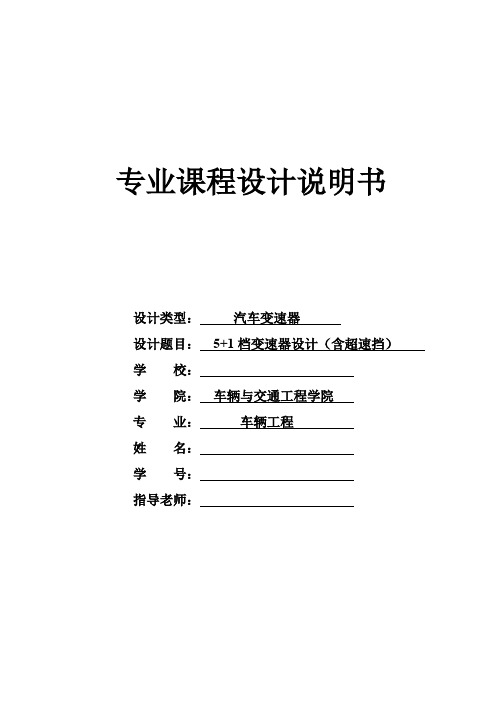
专业课程设计说明书设计类型:汽车变速器设计题目:5+1档变速器设计(含超速挡)学校:学院:车辆与交通工程学院专业:车辆工程姓名:学号:指导老师:目录第1章变速器主要参数的选择与计算 (1)1.1 设计初始数据 (1)1.2 变速器各挡传动比的确定 (1)1.3 变速器传动方案的确定 (3)1.4 中心距的确定 (4)1.5齿轮参数 (4)第2章齿轮的设计计算与校核 (5)2.1 齿轮的设计与计算 (5)2.1.1 各挡齿轮齿数的分配 (5)2.1.2计算各轴的转矩 (11)2.2 轮齿的校核 (12)2.2.1 轮齿弯曲强度计算 (12)2.2.2 轮齿接触应力 (14)第3章轴的设计与计算及轴承的选择与校核 (18)3.1 轴的设计计算 (18)3.1.1 轴的工艺要求 (18)3.1.2 初选轴的直径 (18)3.1.3 轴的强度计算 (19)3.2 轴承的选择及校核 (23)3.2.1 输入轴的轴承选择与校核 (23)3.2.2 输出轴轴承校核 (24)结论 (26)参考文献 (26)第1章 变速器主要参数的选择与计算1.1设计初始数据最高车速:maxa u =165Km/h发动机功率:maxe P =88/4500 Kw/r/min转矩:maxe T =215/2400 Nm/r/min 总质量:am =1500Kg车轮:185/60R141.2变速器各挡传动比的确定初选传动比:m a x a u = 0.3770min ii rn g p 式中:m i ng i —变速器最小传动比 乘用车取0.85maxe T =9549×pe n P maxα (转矩适应系数α=1.1~1.3)所以,pn =9549×215882.1⨯=5653.008r/minpn / T n =1.4~2.0 符合i =0.377×maxmin a g p u i rn =0.377×16585.010********⨯⨯⨯-=4.026双曲面主减速器,当0i≤6时,取η=90%最大传动比1g i 的选择]17[:①满足最大爬坡度。
- 1、下载文档前请自行甄别文档内容的完整性,平台不提供额外的编辑、内容补充、找答案等附加服务。
- 2、"仅部分预览"的文档,不可在线预览部分如存在完整性等问题,可反馈申请退款(可完整预览的文档不适用该条件!)。
- 3、如文档侵犯您的权益,请联系客服反馈,我们会尽快为您处理(人工客服工作时间:9:00-18:30)。
前言.................................................................................................................................................. - 4 -一、手动变速器(MT)................................................................................................................ - 4 -二、自动变速器(AT) ........................................................................................................... - 5 -三、手动/自动变速器(AMT) .............................................................................................. - 5 -四、无级变速器 ........................................................................................................................ - 6 - 第一章机械式变速器的概述及其方案的确定 .............................................................................. - 7 - §1.1 变速器的功用和要求 ....................................................................................................... - 7 - §1.2 变速器结构方案的确定 ................................................................................................... - 8 -1、变速器传动机构的结构分析与型式选择 .................................................................. - 8 -2、倒档传动方案 ............................................................................................................ - 13 -§1.2变速器主要零件结构的方案分析 ................................................................................. - 14 -1.齿轮型式 ............................................................................................错误!未定义书签。
2.换档结构型式 ....................................................................................错误!未定义书签。
第二章变速器主要参数的选择与主要零件的设计 .........................................错误!未定义书签。
§2.1 变速器主要参数的选择 ......................................................................错误!未定义书签。
一、档数和传动比 ...............................................................................错误!未定义书签。
二、中心距 ...........................................................................................错误!未定义书签。
三、轴向尺寸 .......................................................................................错误!未定义书签。
四、齿轮参数 .......................................................................................错误!未定义书签。
§2.2各档传动比及其齿轮齿数的确定 .......................................................错误!未定义书签。
1.确定一档齿轮的齿数 ........................................................................错误!未定义书签。
2.确定常啮合齿轮副的齿数 ................................................................错误!未定义书签。
3.确定其他档位的齿数 ........................................................................错误!未定义书签。
4.确定倒档齿轮的齿数 ........................................................................错误!未定义书签。
§2.3 齿轮变位系数的选择 ..........................................................................错误!未定义书签。
第三章变速器齿轮的强度计算与材料的选择 .................................................错误!未定义书签。
§3.1 齿轮的损坏原因及形式 ......................................................................错误!未定义书签。
§3.2 齿轮的强度计算与校核 ......................................................................错误!未定义书签。
1、齿轮弯曲强度计算 .........................................................................错误!未定义书签。
2. 齿轮接触应力 ..................................................................................错误!未定义书签。
第四章变速器轴的强度计算与校核 .................................................................错误!未定义书签。
§4.1变速器轴的结构和尺寸 .......................................................................错误!未定义书签。
1、轴的结构 .........................................................................................错误!未定义书签。
2、确定轴的尺寸 .................................................................................错误!未定义书签。
§4.2 轴的校核 ..............................................................................................错误!未定义书签。
1、第一轴的强度与刚度校核 .............................................................错误!未定义书签。
2、第二轴的校核计算 .........................................................................错误!未定义书签。
第五章变速器同步器的设计 .............................................................................错误!未定义书签。
1、同步器的结构 .........................................................................................错误!未定义书签。
2.同步环主要参数的确定 .........................................................................错误!未定义书签。
第六章变速器的操纵机构 .................................................................................错误!未定义书签。
第七章结论 .........................................................................................................错误!未定义书签。
参考文献...............................................................................................................错误!未定义书签。
